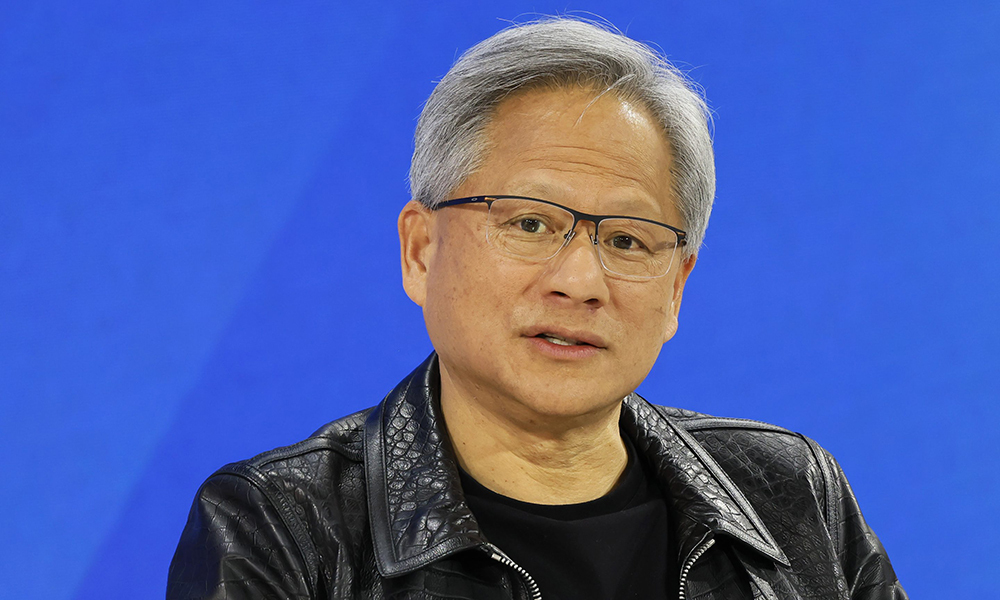
英伟达(Nvidia Corp.)是标普500指数价格最贵的股票,其股票交易价格是公司未来12个月预测销售额的约23倍。
但这个估值存在一个问题。在人工智能繁荣发展时期,无论是关注英伟达的华尔街分析师还是英伟达自己的高管,没有人能够预测该芯片制造商的营收到底将走向何方。那么投资者们该如何计算英伟达的股价是否过高?
距今一年多前,人工智能狂热使英伟达芯片的需求激增,让华尔街的季度财务预估变成了笑柄。分析师们的数据并非胡编乱造,就像预测其他公司的业绩一样,他们的线索来自公司的管理层。然而,就连英伟达领导层也很难预测未来三个月公司将创造多少营收。
英伟达销售额从到2023年4月结束的财季开始激增,从那之后公司营收比公司预测的中间值平均高13%,超过过去十年平均值的两倍。彭博社汇总的数据显示,英伟达去年8月份公布业绩时,其销售额超出预测23%,这至少是自2013年以来幅度最大的一次。
英伟达代表拒绝置评。
销售额预测
晨星(Morningstar)分析师布莱恩·克莱罗认为,模拟预测英伟达营收的困难之处在于,当需求旺盛时供应成为最不确定的变量,这让这家芯片制造商独具特色。上个月,克莱罗将英伟达股票的目标价位从91美元调整至105美元。目前英伟达股票的交易价格约为127美元。
克莱罗表示,假设英伟达能够稳步提升增加供应的能力,他预测英伟达下一季度的销售额,将比其季度营收增加40亿美元。
克莱罗说道:“我不是第一个上调目标价位或公允价值的分析师,也不是第一个对其营收远超过一年前的预期感到惊讶的分析师。预测英伟达的营收很有趣,也会让人收获良多,但确实很有挑战性。”
不只克莱罗提高了预估股价。周五,Melius分析师本·雷特兹今年第五次上调了英伟达的目标价位,从125美元上调至160美元,比周五的收盘价增长了26%。
当然,有许多交易者买入英伟达的原因是市场动量。英伟达股价今年上涨了156%,在周二短暂超过微软(Microsoft Corp.),以3.34万亿美元的估值成为全球最有价值的公司。美国银行(Bank of America Corp.)对EPFR Global的数据所作的分析显示,上周,截至6月19日,英伟达股价上涨使87亿美元资金注入科技基金,创历史记录。之后英伟达股价下跌了6.7%,市值缩水了超过2,000亿美元。
对于倾向于关注贴现现金流模型(现在该模型的波动性更大)的投资者而言,估算和实际结果之间的差异是一个难题。
根据彭博社汇总的数据,过去五个季度,分析师预估的英伟达销售额与实际销售额平均相差12%。在过去五个季度公布的平均季度营收至少达到50亿美元,并且至少有20位分析师进行业绩分析的标普500公司中,这个差距排在第三位。
股价预测
英伟达业务繁荣,而且微软等其最大的客户均承诺未来几个季度将增加计算硬件投入,因此投资者面对的最大问题是,对于利润和销售额增长均遥遥领先于其他大盘股公司的英伟达,其合理的股价是多少。
根据当前的估算,英伟达预计本季度的销售额为284亿美元,盈利147亿美元,比去年同期分别上涨111%和137%。与此同时,微软的销售额预计将上涨15%,苹果的销售额预计将上涨约3%。
虽然英伟达的估值倍数较高,但考虑到英伟达的增长,特别是分析师的预估一直较低,因此这个倍数看起来更加合理。Jonestrading的首席市场策略师迈克尔·奥鲁尔克认为,更值得担忧的一个问题是,由于英伟达庞大的规模,其超出华尔街增长预期的程度将很快开始下降。这可能更难合理确定英伟达的股价。
奥鲁尔克表示:“这就是风险所在。你以高价买入一家高市值公司的股票,但其业绩却呈下降趋势,而且这种趋势可能持续下去。”(财富中文网)
翻译:刘进龙
审校:汪皓
英伟达(Nvidia Corp.)是标普500指数价格最贵的股票,其股票交易价格是公司未来12个月预测销售额的约23倍。
但这个估值存在一个问题。在人工智能繁荣发展时期,无论是关注英伟达的华尔街分析师还是英伟达自己的高管,没有人能够预测该芯片制造商的营收到底将走向何方。那么投资者们该如何计算英伟达的股价是否过高?
距今一年多前,人工智能狂热使英伟达芯片的需求激增,让华尔街的季度财务预估变成了笑柄。分析师们的数据并非胡编乱造,就像预测其他公司的业绩一样,他们的线索来自公司的管理层。然而,就连英伟达领导层也很难预测未来三个月公司将创造多少营收。
英伟达销售额从到2023年4月结束的财季开始激增,从那之后公司营收比公司预测的中间值平均高13%,超过过去十年平均值的两倍。彭博社汇总的数据显示,英伟达去年8月份公布业绩时,其销售额超出预测23%,这至少是自2013年以来幅度最大的一次。
英伟达代表拒绝置评。
销售额预测
晨星(Morningstar)分析师布莱恩·克莱罗认为,模拟预测英伟达营收的困难之处在于,当需求旺盛时供应成为最不确定的变量,这让这家芯片制造商独具特色。上个月,克莱罗将英伟达股票的目标价位从91美元调整至105美元。目前英伟达股票的交易价格约为127美元。
克莱罗表示,假设英伟达能够稳步提升增加供应的能力,他预测英伟达下一季度的销售额,将比其季度营收增加40亿美元。
克莱罗说道:“我不是第一个上调目标价位或公允价值的分析师,也不是第一个对其营收远超过一年前的预期感到惊讶的分析师。预测英伟达的营收很有趣,也会让人收获良多,但确实很有挑战性。”
不只克莱罗提高了预估股价。周五,Melius分析师本·雷特兹今年第五次上调了英伟达的目标价位,从125美元上调至160美元,比周五的收盘价增长了26%。
当然,有许多交易者买入英伟达的原因是市场动量。英伟达股价今年上涨了156%,在周二短暂超过微软(Microsoft Corp.),以3.34万亿美元的估值成为全球最有价值的公司。美国银行(Bank of America Corp.)对EPFR Global的数据所作的分析显示,上周,截至6月19日,英伟达股价上涨使87亿美元资金注入科技基金,创历史记录。之后英伟达股价下跌了6.7%,市值缩水了超过2,000亿美元。
对于倾向于关注贴现现金流模型(现在该模型的波动性更大)的投资者而言,估算和实际结果之间的差异是一个难题。
根据彭博社汇总的数据,过去五个季度,分析师预估的英伟达销售额与实际销售额平均相差12%。在过去五个季度公布的平均季度营收至少达到50亿美元,并且至少有20位分析师进行业绩分析的标普500公司中,这个差距排在第三位。
股价预测
英伟达业务繁荣,而且微软等其最大的客户均承诺未来几个季度将增加计算硬件投入,因此投资者面对的最大问题是,对于利润和销售额增长均遥遥领先于其他大盘股公司的英伟达,其合理的股价是多少。
根据当前的估算,英伟达预计本季度的销售额为284亿美元,盈利147亿美元,比去年同期分别上涨111%和137%。与此同时,微软的销售额预计将上涨15%,苹果的销售额预计将上涨约3%。
虽然英伟达的估值倍数较高,但考虑到英伟达的增长,特别是分析师的预估一直较低,因此这个倍数看起来更加合理。Jonestrading的首席市场策略师迈克尔·奥鲁尔克认为,更值得担忧的一个问题是,由于英伟达庞大的规模,其超出华尔街增长预期的程度将很快开始下降。这可能更难合理确定英伟达的股价。
奥鲁尔克表示:“这就是风险所在。你以高价买入一家高市值公司的股票,但其业绩却呈下降趋势,而且这种趋势可能持续下去。”(财富中文网)
翻译:刘进龙
审校:汪皓
Nvidia Corp. is the most expensive stock in the S&P 500 Index, with its shares trading for roughly 23 times the company’s projected sales over the next 12 months.
But there’s a problem with that valuation. In the age of the artificial intelligence boom, no one can figure out what the chipmaker’s revenues are actually going to be — not the Wall Street analysts covering Nvidia or Nvidia executives themselves. So how are investors supposed to calculate whether the shares are expensive or not?
For more than a year now, a surge in demand for Nvidia’s chips sparked by the frenzy surrounding AI has made a mockery of Wall Street’s quarterly financial estimates. Analysts aren’t making up numbers, they take their cues from management like they do with every other company. However, even Nvidia’s leadership is struggling to anticipate how much money the chipmaker will generate three months into the future.
Since Nvidia’s sales began exploding in its fiscal quarter that ended in April 2023, revenue has exceeded the midpoint of the company’s own forecast by an average of 13%, more than twice the average over the past decade. When Nvidia reported results in August, sales topped its projection by 23%, the biggest beat since at least 2013, according to data compiled by Bloomberg.
A representative for Nvidia declined to comment.
Ballparking Sales
Part of what makes modeling for Nvidia so difficult is that supply is the most uncertain variable when demand is booming, making the chipmaker unique, according to Brian Colello, an analyst at Morningstar, who last month raised his price target for the shares to $105 from $91. They’re currently trading at around $127.
Assuming steady improvement in Nvidia’s ability to increase supply, Colello said he adds up to $4 billion to Nvidia’s quarterly revenue to ballpark the upcoming quarter’s sales.
“I’m not the first analyst to be raising my price target or fair value or being surprised that revenues are far ahead of what we thought a year ago,” Colello said. “It’s been interesting and rewarding but certainly challenging.”
Colello isn’t the only one raising his price estimate. On Friday, Melius analyst Ben Reitzes raised his price target on Nvidia for the fifth time this year, to $160 from $125, implying a gain of 26% from Friday’s closing price.
Of course, there are plenty of traders buying Nvidia solely based on momentum. Nvidia has gained 156% this year and overtook Microsoft Corp. on Tuesday to briefly become the world’s most valuable company at $3.34 trillion. That rally helped drive a record $8.7 billion into tech funds last week through June 19, according to a Bank of America Corp.’s analysis of data from EPFR Global. Nvidia shares have since fallen 6.7%, erasing more than $200 billion in market value.
For investors inclined to stare at discounted cash flow models that have more variability than they have in the past, the gap between estimates and actual results has created a conundrum.
In the past five quarters, analyst estimates for Nvidia’s sales have deviated from actual results by an average of 12%, according to data compiled by Bloomberg. That’s the third-most among the S&P 500 companies that have posted average quarterly revenue of at least $5 billion in the last five quarters and have at least 20 analysts covering them.
What Price?
With Nvidia’s business booming and its biggest customers like Microsoft pledging to spend even more on computing hardware in coming quarters, the main question for investors is what’s a reasonable price to pay for a stock whose profit and sales growth is far superior to its megacap peers.
Based on current estimates, Nvidia is projected to deliver profit of $14.7 billion on sales of $28.4 billion in the current quarter, up 137% and 111%, respectively, from the same period a year ago. Meanwhile, Microsoft’s sales are expected to rise 15% with Apple projections sitting around 3%.
While Nvidia’s valuation multiples are rich, they look more reasonable given Nvidia’s growth, especially considering the estimates keep coming in low. To Michael O’Rourke, chief market strategist at Jonestrading, a bigger concern is that the degree to which Nvidia surpasses Wall Street’s growth expectations will soon start subsiding, just due to the company’s sheer size. That could make it harder to justify the shares’ price tag.
“That’s where the risk comes in,” O’Rourke said. “You’re paying a high price for a large market cap company where the beats have been trending lower and that’s likely to continue.”






